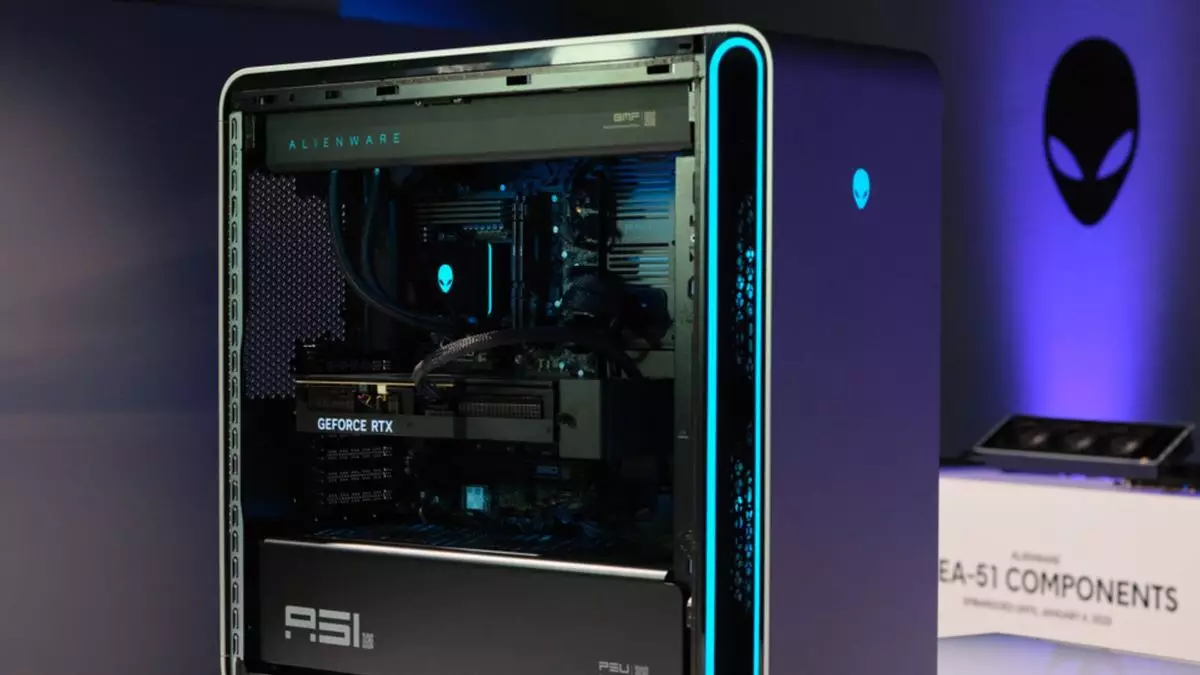Gaming enthusiasts have long been at the mercy of major brands that prioritize sleek aesthetics over upgradability, and Alienware has historically exemplified this trend. Renowned for its high-performance gaming rigs adorned with striking designs, Alienware has made strides to address consumer frustrations regarding upgrade limitations – but is it truly enough? The recent unveiling of the Area-51 desktop rig at CES created buzz with promises of improved upgradability, only to reveal complexities that might leave potential buyers feeling both intrigued and frustrated.
Alienware’s Upgrade Dichotomy: What You Need to Know
At CES, expectation surrounded Alienware’s announcement of the fully upgradeable Area-51, hinting at a future where gaming rigs could grow alongside their owners’ aspirations. However, the devil is in the details. Alienware introduced a “conversion kit” for $35, touted as essential for connecting third-party motherboards to its new chassis, effectively dampening the excitement generated by the original reveal. While the kit includes necessary components like a power switch wiring cable and USB dongle extension, the additional cost introduces a question: Does this negate the notion of a truly upgradeable system?
From a practical standpoint, the conversion kit emphasizes Alienware’s continued reliance on proprietary components, which can alienate seasoned PC builders. Moreover, users with older Area-51 models are notably sidelined, as the kit appears incompatible with prior versions, leading to the suspicion that Alienware may be subtly encouraging repeat customers rather than respecting loyalty. What was envisaged as a significant leap forward morphs into a reminder of constraints – a duality representative of Alienware’s ongoing struggles between innovation and restriction.
Technical Enhancements: A Silver Lining Amidst Clouds
Despite the limitations introduced by the conversion kit, Alienware boasts that the Area-51 delivers cutting-edge technology. With the latest RTX 50 series graphics cards and a promise of enhanced thermal dynamics, the system claims to operate at temperatures up to 13% cooler and noise levels up to 45% quieter than previous models. The concept of positive pressure airflow is particularly impressive, as it suggests that users won’t just enjoy better performance but also benefit from cleaner internal environments, thanks to reduced dust accumulation.
Furthermore, the potential for modular upgrades—including GPU, RAM, and SSD replacements without the limitations of the motherboard—offers a glimmer of hope for gamers wanting to stay ahead of the curve. Quick response efforts, such as QR codes next to upgradeable components, enhance the user experience by simplifying the upgrade process. While one can see improvement in design and usability with these features, the core question of motherboard limitation starkly flips the script on what could have been a hard-hitting victory for Alienware.
Navigating Through Consumer Frustrations
The sentiment surrounding the Area-51 seems to resonate with a collective ambivalence among fans and gamers. On the one hand, the rig’s impressive specs and features signify a marked shift towards performance. On the other hand, the $35 conversion kit periphery casts a shadow over the enthusiasm. It becomes apparent that both casual gamers and hardcore enthusiasts may find themselves wrestling with Alienware’s apparent reluctance to embrace true modularity. The sentiment can be captured simply: appreciation mixed with dissatisfaction.
In a world where customization is paramount, enthusiasts take pride in tailoring their rigs to their specific needs and preferences. Alienware’s current direction may generate some initial intrigue, but it risks driving tech-savvy consumers straight towards competitors who prioritize genuine modular architecture and consumer-friendly policies. It’s a precarious balancing act; while Alienware strives to remain relevant amidst fierce competition, a feeling of compromise permeates the narrative.
As the gaming landscape rapidly evolves, the response from brands like Alienware will ultimately decide who retains loyalty from consumers. Will they embrace true flexibility and upgradability, or will they continue to minimize options under the guise of aesthetics and brand loyalty? The new Area-51 rigs look impressive, but they remain that ambiguous enigma, a shining beacon of potential dimmed by strings attached. As consumers tread these waters, the question lingers: are we witnessing the birth of a game-changing era in gaming rigs or merely more of the same?

